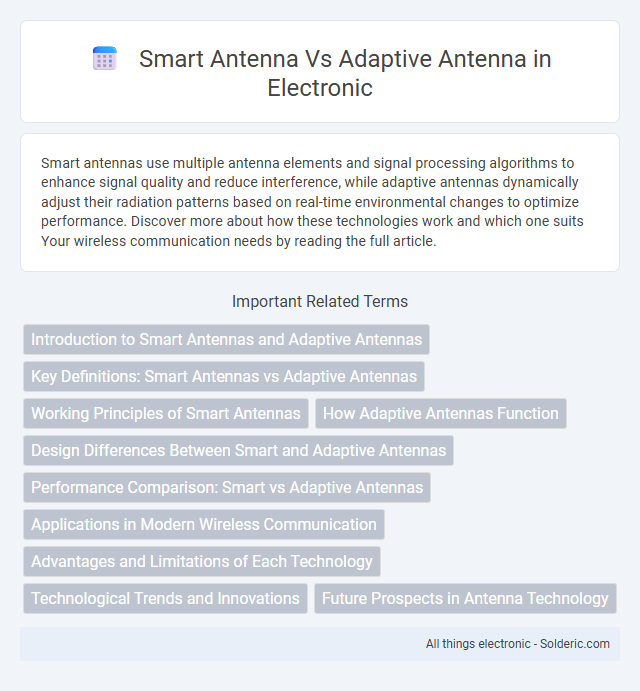Smart antennas use multiple antenna elements and signal processing algorithms to enhance signal quality and reduce interference, while adaptive antennas dynamically adjust their radiation patterns based on real-time environmental changes to optimize performance. Discover more about how these technologies work and which one suits Your wireless communication needs by reading the full article.
Comparison Table
| Feature | Smart Antenna | Adaptive Antenna |
|---|---|---|
| Definition | Array of antennas that dynamically manage signal coverage and interference | Type of smart antenna that adjusts beam patterns based on environment and signals |
| Function | Optimizes signal direction and reduces interference | Continuously adapts beamforming for changing signal conditions |
| Beamforming | Fixed or pre-set beam patterns | Dynamic, real-time beamforming with feedback loops |
| Signal Processing | Basic signal combining and switching | Advanced algorithms for interference cancellation and signal enhancement |
| Applications | Cellular networks, Wi-Fi, radar systems | Military communication, wireless broadband, satellite systems |
| Complexity | Moderate | High |
| Cost | Lower | Higher due to adaptive processing |
Introduction to Smart Antennas and Adaptive Antennas
Smart antennas use predefined radiation patterns to enhance signal quality and reduce interference, leveraging spatial filtering for improved wireless communication. Adaptive antennas dynamically adjust their beam patterns in real-time based on the changing signal environment, optimizing performance by continuously learning from signal characteristics. Your choice between smart and adaptive antennas depends on the complexity of the communication system and the need for real-time signal adaptation.
Key Definitions: Smart Antennas vs Adaptive Antennas
Smart antennas integrate multiple antenna elements with signal processing algorithms to dynamically adjust radiation patterns for improved signal quality and interference reduction. Adaptive antennas continuously monitor the signal environment and automatically modify their beamforming parameters to optimize performance in real-time, typically through feedback mechanisms. Understanding the distinction helps you select the appropriate technology for applications requiring enhanced spatial signal processing and adaptive communication capabilities.
Working Principles of Smart Antennas
Smart antennas use fixed beamforming algorithms to direct signals towards intended users, enhancing signal strength and reducing interference. They rely on spatial filtering techniques to process multiple signals simultaneously, improving network capacity and coverage. Adaptive antennas dynamically adjust their beam patterns in real-time based on signal environment changes, continuously optimizing performance through feedback mechanisms and signal processing algorithms.
How Adaptive Antennas Function
Adaptive antennas function by dynamically adjusting their radiation patterns to optimize signal reception and transmission based on the real-time wireless environment. Utilizing advanced algorithms, they continuously analyze incoming signals and interference to steer nulls towards noise sources and maximize gain in desired directions. Your communication system benefits from improved signal quality and reduced interference through this intelligent, responsive antenna behavior.
Design Differences Between Smart and Adaptive Antennas
Smart antennas utilize predefined beamforming algorithms and multiple fixed antenna elements to enhance signal direction and minimize interference, relying on spatial diversity for optimized coverage. Adaptive antennas continuously adjust their radiation patterns in real-time using feedback from the environment, employing dynamic signal processing techniques to adapt to changing conditions and user movements. The key design difference lies in the adaptability of the antenna array: smart antennas follow preset strategies, while adaptive antennas modify their configurations responsively to optimize performance.
Performance Comparison: Smart vs Adaptive Antennas
Smart antennas enhance wireless communication by using fixed beamforming techniques to improve signal quality and reduce interference, leading to higher capacity in static environments. Adaptive antennas continuously adjust their beam patterns in real time to dynamically track signal sources and mitigate fading, offering superior performance in complex, rapidly changing conditions. Your choice depends on application requirements, with adaptive antennas excelling in environments demanding real-time responsiveness and smart antennas providing efficient solutions in predictable settings.
Applications in Modern Wireless Communication
Smart antennas enhance wireless communication by using beamforming techniques to improve signal quality and reduce interference in cellular networks, Wi-Fi systems, and satellite communications. Adaptive antennas dynamically adjust their radiation patterns in real-time to optimize signal reception and transmission, making them ideal for environments with rapidly changing conditions such as mobile networks and radar systems. Both technologies are integral to 5G networks, improving coverage, capacity, and spectral efficiency.
Advantages and Limitations of Each Technology
Smart antennas improve wireless communication by dynamically directing beams toward users, increasing signal strength and reducing interference, but they may face challenges in complex multipath environments. Adaptive antennas constantly adjust their patterns to changing signal conditions, offering superior interference mitigation and improved link quality, though they require higher computational resources and sophisticated algorithms. Your choice depends on balancing performance benefits with the system's complexity and processing capabilities.
Technological Trends and Innovations
Smart antennas leverage fixed beamforming algorithms to enhance signal quality and reduce interference by focusing on predetermined directions, while adaptive antennas employ real-time signal processing to dynamically adjust beam patterns for optimal performance in changing environments. Innovations in machine learning and AI have propelled adaptive antennas to the forefront of wireless communication, enabling more accurate channel estimation and interference mitigation. Your network can benefit from these technological trends by integrating adaptive antenna systems that maximize spectral efficiency and support evolving 5G and beyond wireless standards.
Future Prospects in Antenna Technology
Smart antenna systems leverage multiple antenna elements with signal processing algorithms to dynamically optimize beamforming and spatial filtering, enhancing wireless communication capacity and reliability. Adaptive antennas extend this by continuously adjusting their radiation patterns in response to changing signal environments, enabling robust interference mitigation and optimal signal reception in real-time. The future of antenna technology hinges on integrating machine learning techniques with smart and adaptive antennas to achieve ultra-low latency, higher spectral efficiency, and seamless connectivity in next-generation 5G and 6G networks.
smart antenna vs adaptive antenna Infographic

 solderic.com
solderic.com